On October 6, 1966 (Stardate: 1672.1), NBC aired Episode 5 of Star Trek, titled “The Enemy Within.” Captain James T. Kirk has just beamed up from planet Alpha 177, where magnetic anomalies have caused the transporter to malfunction (as it is wont to do as a plot device), splitting Kirk into two entities, one who is cool and rational and the other who is impulsive and violent. Angelic Kirk must make a command decision to avert disaster and save his crew but he is paralyzed with indecision, bemoaning to the ship’s doctor: “I can’t survive without him [demonic Kirk]. I don’t want to take him back. He’s like an animal — a thoughtless, brutal animal. And yet it’s me.” Dr. McCoy’s resolution unites the two: “We all have our darker side — we need it! It’s half of what we are. It’s not really ugly — it’s human.”1
This vignette captures an underlying theme of the two-hour PBS NOVA film The Violence Paradox, based on Harvard psychologist Steven Pinker’s magisterial 2011 book The Better Angels of Our Nature, one of the most important works in the history of the social sciences.2 The film tracks the research of archaeologists, anthropologists, historians, neuroscientists, psychologists, policy makers, and activists around the globe studying violence and working to reduce it. It answers in the affirmative the question Pinker set out to study: is it possible we are living in one of the most peaceful eras in human existence?

Steven Pinker in The Violence Paradox
The story of human violence spans the entirety of our species’ existence, and the film reviews the evidence Pinker amassed that demonstrates just how violent our Paleolithic ancestors were. Far from cherry-picking his data from scarce archaeological and anthropological sources (as some critics have accused him of doing3), Pinker’s conclusion that humans were far more violent in the past than we are today is born out in studies published since 2011. NOVA added, for example, the results of a recent survey of some 600 archaeological sites spanning the last 50,000 years, which found rates of violent deaths were at least three times higher than today. The film continues its journey across space and time, demonstrating how once common and socially sanctioned ghastly practices such as human sacrifice, witch burning, torture, and infanticide have become rare in our world today, even if not completely eradicated.
The film then considers what forces may have prompted the better angels of our nature to ride herd over our inner demons, proposing (pace Pinker) the theory that widening notions of equality, alongside shifting social norms emphasizing self-control, changed public attitudes and behavior that led people to act more civilized and thus less violent. This theory was first proposed in 1939 in a book called The Civilizing Process by the sociologist Norbert Elias, whom Pinker calls “the most important thinker you’ve never heard of.” Pinker summarizes the theory succinctly:
Beginning in the 11th or 12th and maturing in the 17th and 18th [centuries], Europeans increasingly inhibited their impulses, anticipated the long-term consequences of their actions, and took other people’s thoughts and feelings into consideration. A culture of honor — the readiness to take revenge — gave way to a culture of dignity — the readiness to control one’s emotions. These ideals originated in explicit instructions that cultural arbiters gave to aristocrats and noblemen, allowing them to differentiate themselves from the villains and boors. But they were then absorbed into the socialization of younger and younger children until they became second nature.4
Second nature. Our first nature is to be selfish, greedy, and nasty — our inner demons. Our second nature — our better angels — requires a little coaxing and persuading to come out. Analysis of medieval books of etiquette, for example — which Elias analyzes — reveal numerous impulse control prohibitions, including:
- Don’t foul the staircases, corridors, closets or wall hangings with urine or other filth.
- Don’t relieve yourself in front of ladies. · Don’t touch your private parts under your clothes with your bare hands.
- Don’t greet someone while they are urinating or defecating.
- Don’t make noise when you pass gas.
- Don’t blow your nose onto the tablecloth.
- Don’t spit into the bowl when washing.
- Don’t pick your nose while eating.5
In short, our medieval ancestors were uncouth, ill-mannered, and, well, uncivilized. These many proscriptions are reducible to a few principles related to this second nature of self-control, as Pinker explains: “Control your appetites; Delay gratification; Consider the sensibilities of others; Don’t act like a peasant; Distance yourself from your animal nature.” Externally, other forces were at work as well to curb our inner demons, as Pinker notes: “the centralization of state control and its monopolization of violence, the growth of craft guilds and bureaucracies, the replacement of barter with money, the development of technology, the enhancement of trade, the growing webs of dependency among far-flung individuals,” and the like.
The evidence that our better angels are winning out over our inner demons is as compelling as it is diverse. For example, a groundbreaking analysis of written records in Europe from the Middle Ages to today, conducted by University of Cambridge criminologist Manuel Eisner, found that homicide rates have fallen, for example, from 110 homicides per 100,000 people per year in 14th-century Oxford to less than 1 homicide per 100,000 in mid-20th-century London. Similar patterns have been documented in Italy, Germany, Switzerland, the Netherlands and Scandinavia. The longer-term trend is even more dramatic, Pinker told me in an email: “Violent deaths of all kinds have declined, from around 500 per 100,000 people per year in prestate societies to around 50 in the Middle Ages, to around 6 to 8 today worldwide, and fewer than 1 in most of Europe.”6 The film’s dramatic visuals of downward trending data curves captures the decline throughout the centuries.
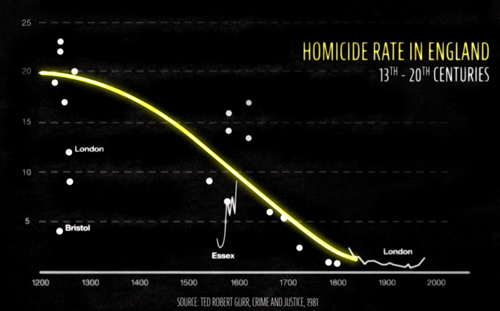
Homicide rates have fallen from 110 homicides per 100,000 people per year in 14th-century Oxford to less than 1 homicide per 100,000 in mid-20th-century London.
A remarkable new study conducted by the Carnegie Mellon data scientist Simon Dedeo is also highlighted in the special, in which digitized court proceedings of the Old Bailey (the central criminal court of London) were analyzed by an artificial intelligence algorithm scanning keywords recorded in 197,745 trials between 1674 and 1913.7 The words spoken in court reflected the attitudes toward violence by the people at the time, and the way crimes were classified and discussed was changing decade by decade. Early on, for example, a crime of theft might include many descriptors of violence (stabbed, beaten, clubbed) that accompanied the act, but the perpetrator was convicted for robbery, not for assault. Over time, violent words became more correlated with violent crimes, in which Dedeo found that British society became markedly less tolerant of violence. “By the early 20th century, people were expected to settle their disputes in ways that didn’t involve breaking a nose or taking out a couple of teeth,” says Dedeo’s colleague Tim Hitchcock, who originally scanned the 127 million words from the archives.
Some “declinist” skeptics are included in the film, pointing out that during the same period in which Europeans started acting less violently towards each other, they conducted one of the bloodiest chapters in human history: the global slave trade and the colonial conquests of non-European peoples. As Yale historian Carolyn Roberts explains on camera: “These slave ships that are plying the Atlantic with human cargo, these are mini war zones where you have mortality levels that are between 10 and 25 percent on every voyage. And it lasted for nearly 400 years.” Surely the horrors of the transatlantic slave trade and the subjugation and genocide of indigenous peoples count as violence. Indeed they do, along with the practice of torture and other cruel and unusual punishments. But that slavery has been outlawed by every nation on earth, that none practice colonialism any longer, and that very few engage in torture, is yet another sign of moral progress.
What about the two hemoclysmic world wars of the 20th century, not to mention the existential threat posed by nuclear weapons? Are these not data points suggesting a trajectory of violence that has ticked upwards? In absolute numbers, yes. But not as a percentage of total global population. As Pinker told me: “On average, nonstate societies kill around 15 percent of their people in wars, whereas today’s states kill a few hundredths of a percent.” Pinker calculates that even in the murderous 20th century, about 40 million people died in war out of the approximately six billion people who lived, or 0.7 percent. Even if we include war-related deaths of citizens from disease, famines and genocides, that brings the death toll up to 180 million deaths, or about 3 percent. Compare these figures to the cataclysm of the Mongol conquests of the 13th century, which are estimated to have killed roughly 40 million people, or roughly 10 percent of the world’s population at the time.
The trend in war deaths has gone down even further in recent decades thanks to the fact that the great powers have quit fighting one another directly. Yes, they have waged proxy wars like Vietnam, but the era of massive clashes of great power armies appears to have come to an end. Here is a graph tracking the decline of political violence from 1939 to 2011 in average annual deaths for all armed conflicts in millions.
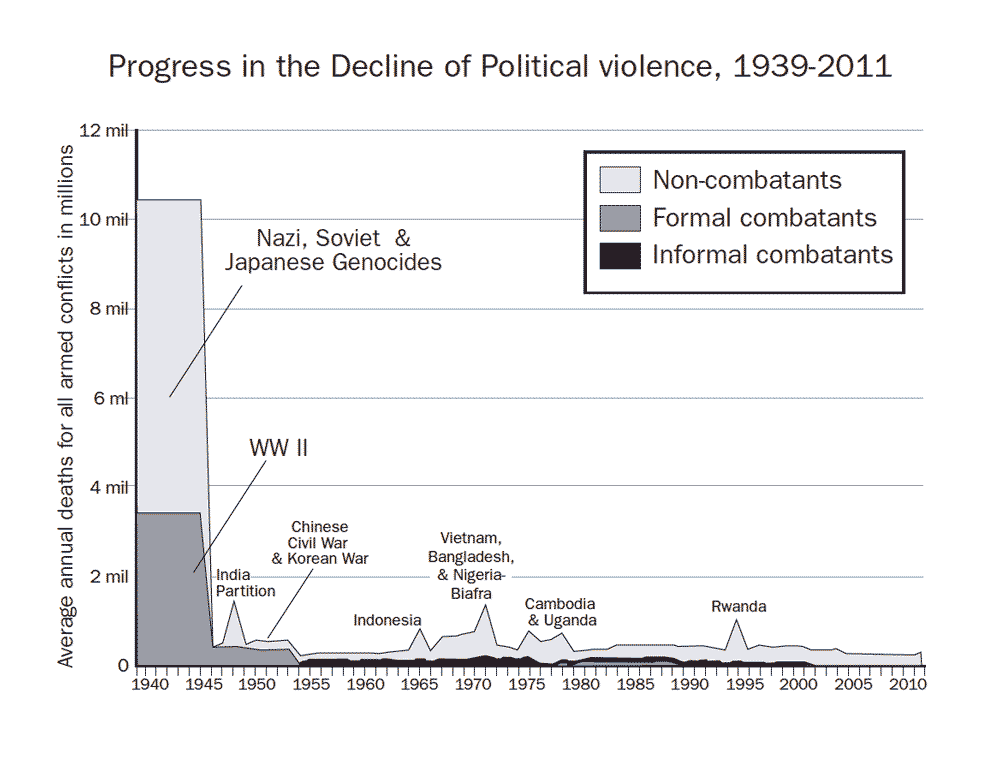
The decline of political violence from 1939 to 2011 in average annual deaths for all armed conflicts in millions
Why, then, despite such positive patterns in the data, does the world feel more dangerous than ever? Because, political scientist Robert Muggah explains to the camera, “We are a super saturated 24/7 information society, and when it bleeds it leads.”
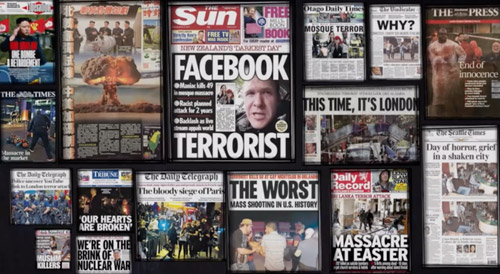
Media headlines: when it bleeds it leads
Muggah also notes that aggregate data, while powerful, can only tell us so much. For example, homicide rates have declined dramatically across the United States as a whole, to about 5 deaths per 100,000 people per year. But when you drill down, some cities have rates up to 10 times higher. Why are some places more violent than others? What can the past tell us about violence today? History suggests that some of the factors driving violence down are a strong government, education, and equality. But those conditions are not evenly distributed, so the film ends by tracking the work of activists in inner cities and global hot spots to nip violence in the bud of where it begins, identifying exactly who is committing violence and where.
The program notes for The Violence Paradox film screener asks, “Can science help tip the balance toward peace?” An affirmative answer to the question is the premise of my 2015 book The Moral Arc8, and my explanation for the apparent “violence paradox” begins with Richard Dawkins’ The Selfish Gene. The film doesn’t go there, but most evolutionary psychologists do (as Pinker does in his book) when they want to explain the evolutionary origins of human behavior. We are survival machines, Dawkins notes, built by replicators called genes.9 A cell, or body, or organism — a survival machine — is the gene’s way of perpetuating itself. Genes that code for proteins that build survival machines that live long enough for them to reproduce will win out over genes that do not. Genes that code for proteins and enzymes that protect its survival machine from assaults such as disease, help not just the organism to survive, but the genes as well. The problem is that survival machines scurrying around in their environment will encounter other survival machines, all of whom are competing for the same limited resources. “To a survival machine, another survival machine (which is not its own child or another close relative) is part of its environment, like a rock or a river or a lump of food,” says Dawkins. But there’s a difference between a survival machine and a rock. A survival machine “is inclined to hit back” if exploited. “This is because it too is a machine that holds its immortal genes in trust for the future, and it too will stop at nothing to preserve them.” Thus, “Natural selection favors genes that control their survival machines in such a way that they make the best use of their environment. This includes making the best use of other survival machines, both of the same and of different species.”10
Survival machines could evolve to be completely selfish and self-centered, but there is something that keeps their pure selfishness in check, and that is the fact that other survival machines are inclined “to hit back” if attacked, to retaliate if exploited, or to attempt to use or abuse other survival machines first. So in addition to selfish emotions that drive survival machines to want to hoard all resources for themselves, they evolved two additional pathways to survival in interacting with other survival machines: kin altruism (“blood is thicker than water”) and reciprocal altruism (“I’ll scratch your back if you’ll scratch mine”). By helping its genetically-related kin, and by extending a helping hand to those who will reciprocate its altruistic acts, a survival machine is helping itself. Thus, there will be a selection for those who are inclined to be altruistic — to a point. With limited resources, a survival machine can’t afford to help all other survival machines, so it must assess whom to help, whom to exploit, and whom to leave alone. It’s a balancing act. If you’re too selfish other survival machines will punish you; if you’re too selfless other survival machines will exploit you. Thus, developing positive relationships — social bonds — with other survival machines is an adaptive strategy. If you are there to help your fellow group members when times are tough for them, they are more likely to be there when times are tough for you.
This evolutionary approach helps us see that there is a certain evolutionary logic to violence and aggression, a taxonomy of which Pinker classified into five types (not featured in the film), which I summarized in The Moral Arc as follows:11
- Predatory and Instrumental: violence as a means to an end, a way of getting something you want.
- Dominance and Honor: violence as a means of gaining status in a hierarchy, power over others, prestige in a group, or glory in gangs and war. And a reputation for being aggressive can be a credible deterrent against other aggressors.
- Revenge and Self-Help Justice: violence as a means of punishment, retribution, and moralistic justice.12 Revenge murders, for example, are an evolved strategy for dealing with cheaters and free riders. Jealousy evolved to direct survival machines to mate guard against potential poachers of their sexual partner, which when expressed violently can lead to spousal murders.
- Sadism: violence as a means of gaining pleasure at someone else’s suffering. Serial killers and rapists, for example, seem at least partially motived by the pain and suffering they cause, especially when it has no other apparent motive (such as instrumental, dominance, or revenge).
- Ideology: violence as a means of attaining some political, social, or religious end that results in a utilitarian calculus whereby killing some for the sake of many is justified.
This, I believe, resolves the paradox of violence, but there is one deeper issue still, hinted at in the NOVA film but not addressed in depth, and that is the nature war. The idea that war is not purely a learned cultural phenomenon bothers not a few commentators, scholars, and social scientists, some of whom react so aggressively that they have been called the “peace and harmony mafia.”13 On the other side are what these Mafioso pejoratively call the “Harvard Hawks” (an invidious smear meant to imply that they favor war over peace)14 — Richard Wrangham, Steven LeBlanc, Edward O. Wilson, and Steven Pinker — who, as I have argued in this essay, contend that war is the outcome of the logic of evolutionary dynamics. Since the 2011 publication of Pinker’s book much has been written about this issue. While writing this essay I queried Pinker about recent criticisms leveled at him by John Horgan, Chrisopher Ryan, and others. Here is his response:
Though this debate is often framed as hunter-gatherers versus everyone else, that was not my argument in Better Angels. Since I was advocating the Hobbesian view that violence is inevitable in a state of anarchy, the question is whether anarchic societies (be they hunter-gatherer, horticulturalist, pastoral, or agricultural) are less violent that states societies. In 2016 an incredibly comprehensive survey was published in Nature.16 Here’s the bottom line: State societies have lower rates of killing (in deaths/100K/year) than bands, tribes, and chiefdoms, both in the archeological record (first four rows) and in contemporary statistics (last three):

State societies have lower rates of killing (in deaths/100K/year) than bands, tribes, and chiefdoms, both in the archeological record (first four rows) and in contemporary statistics.
Here is the figure summarizing all of the data comparing the percentage of war deaths in state societies and non-state societies (from The Moral Arc, based on the figure in Pinker’s book):
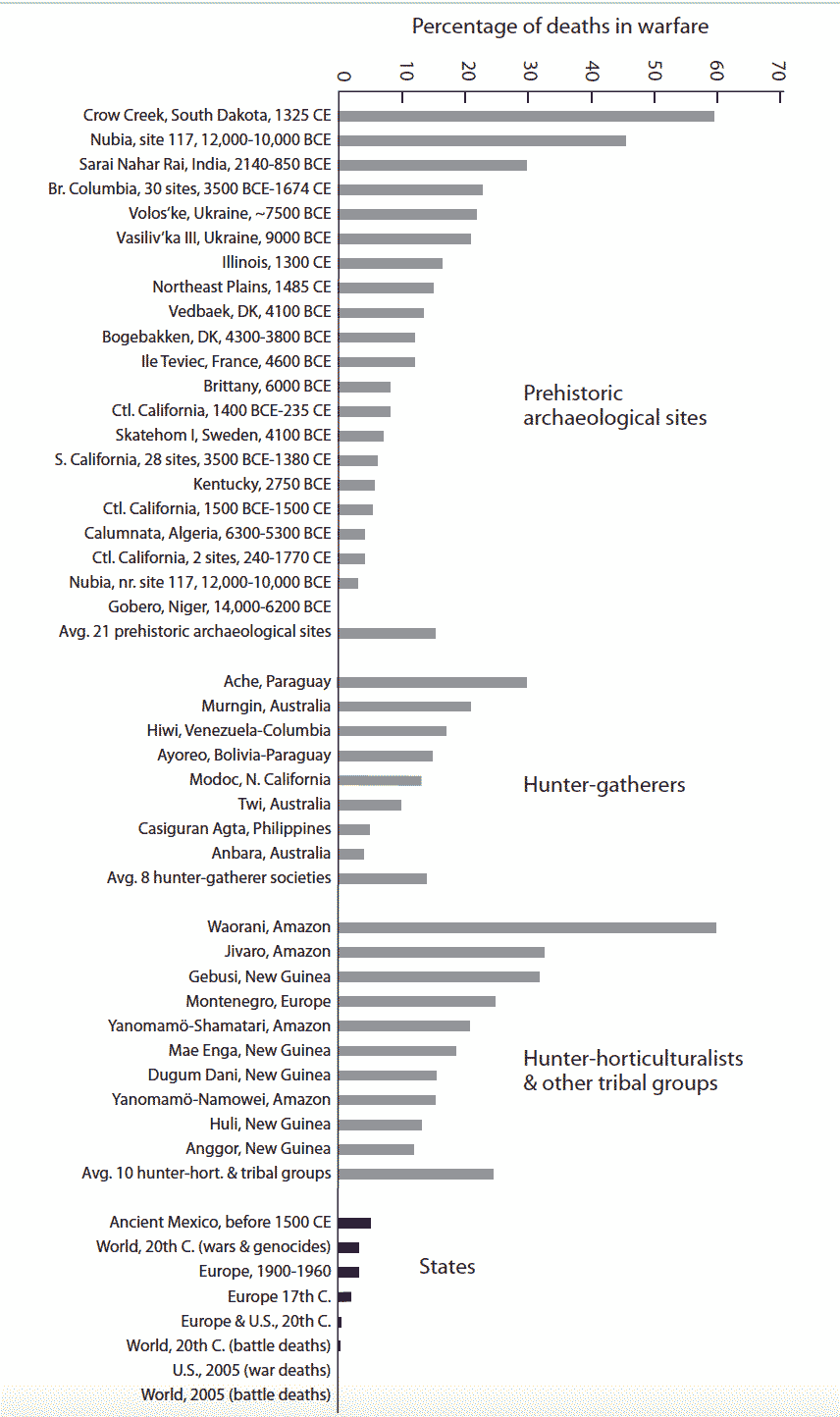
Click image to enlarge. Data comparing the percentage of war deaths in state societies and non-state societies.
In The Moral Arc I reviewed the literature on the nature of war and human nature, including studies published after Pinker compiled his data sets. Here is a shortened encapsulation of my analysis.
In a 2013 edited volume on War, Peace, and Human Nature, Brian Ferguson claims that the data sets in “Pinker’s List” greatly exaggerate prehistoric war mortality; unfortunately, he then confuses frequency (rates) with tendency (inevitability) when he challenges “the idea that deadly intergroup violence has been common enough in our species evolutionary history to act as a selection force shaping human psychological tendencies toward either external violence or internal cooperation.”17 But Pinker is not arguing that the rate of violence in the past acts as a selective force in human evolution; quite the opposite, in fact — the logic of game theoretic interactions between players means that a certain amount of defection (in games) or violence (in life) is inevitable when there is no outside governing body (an association in sports, a government in society) to tilt the matrix toward more cooperative and peaceful choices via both rewards and punishments. Over the millennia we have learned how to adjust the conditions of the matrix of life in order to make people interact in less violent and more peaceable and cooperative ways, and it is those adjustments that have led to a decline of violence and moral progress.18
In a 2013 paper in Science, Douglas Fry and Patrik Söderberg disputed the theory that war is prevalent in mobile foraging band societies (MFBS) by claiming that in a sample of 148 episodes from 21 MFBS: “more than half of the lethal aggression events were perpetrated by lone individuals, and almost two-thirds resulted from accidents, interfamilial disputes, within-group executions, or interpersonal motives such as competition over a particular woman.” From this they conclude, “most incidents of lethal aggression among MFBS may be classified as homicides, a few others as feuds, and a minority as war.”19 Well, that’s comforting! So bashed in skulls and skeletons with embedded arrowheads (such as the one I photographed) were of individuals who were bludgeoned to death by friends within their tribes rather than by enemies from other tribes, or they accidentally shot themselves in the chest with arrows.
Addressing the point about what the data actually indicate, Fry and Söderberg target Samuel Bowles, accusing him of claiming that “war is prevalent in MBFS” and that “war has been pervasive during human evolution.” Bowles responded to this charge: “I did not make the two claims that the authors attribute to me for the simple reason that I was answering a different question.” The question Bowles was trying to answer is: “Did warfare among ancestral hunter-gatherer groups affect the evolution of human social behaviors?” To that end, Bowles explains, “I needed data on the fraction of all deaths that were due to intergroup conflict, not the evidence that Fry and Söderberg present, namely data on whether ‘war’ is ‘prevalent’ or ‘pervasive’ or the major source of violent deaths.”20
Here we see how categorical binary thinking clouds the issue. Forcing a continuum of violence into a category of “prevalent” or “pervasive” misses the point of what we’re interested in knowing here: whatever the rate of violence in the past — by whatever the means and whatever the cause — was it enough to affect human evolution? If you insist that the rate must be high enough to be called “prevalent” or “pervasive” then you have to operationally define these terms with a quantity, including the term “war” that by today’s definition has no meaning for the type of intergroup conflicts that happened during the Late Pleistocene epoch in which our species came of age. As Bowles explains: “In my models of the evolution of human behaviour, the appropriate usage of the term [war] is ‘events in which coalitions of members of a group seek to inflict bodily harm on one or more members of another group;’ and I have included ‘ambushes, revenge murders and other kinds of hostilities’ analogizing human intergroup conflict during the Late Pleistocene to ‘boundary conflicts among chimpanzees’ rather than ‘pitched battles of modern warfare’.”21
Modern urban gangs, for example, engage in violent intergroup conflict that cumulatively can rack up significant body counts. Think of the ongoing Mexican Drug Wars among rival cartels in which over 100,000 people have been killed and over a million displaced since 2006.22 Yet scholars would not classify these events as “wars” because the motives are more commonly related to honor, revenge, feuding, or turf wars. But as Bowles points out, urban gangs meet the criteria for what constitutes an MFBS: small group size, fluctuating group membership, multi-local residence, and a type of egalitarianism with no authority to order others to fight. Bowles carefully examined the data that Fry and Söderberg published in their paper and noted that “motives such as ‘revenge’ or killing ‘over a particular man’ or the fact that a killing was ‘interpersonal’ mean that the event did not fall under the heading of ‘war’.” And yet, Bowles concludes, “From the standpoint of evolutionary biology these aspects of the killing are irrelevant: what matters for the dynamics of population composition is that members of a group (more than one) cooperated in killing a member of another group, for any reason whatever.”23
It’s a point well made in The Arc of War by the political scientists Jack Levy and William Thompson, who begin by adopting a continuous rather than categorical style of reasoning: “War is a persistent feature of world politics, but it is not a constant. It varies over time and space in frequency, duration, severity, causes, consequences, and other dimensions. War is a social practice adopted to achieve specific purposes, but those practices vary with changing political, economic, and social environments and with the goals and constraints induced by those environments.”24 When nuanced in this continuous rather than categorical manner, we can see both how and when rates of warfare change. By defining war as “sustained, coordinated violence between political organizations,”25 however, Levy and Thompson have defined away prehistoric group conflicts that don’t at all resemble political organizations of today. As such, “war” cannot even begin until there are political organizations of a substantive size, which necessarily means that what we think of as war, by definition, was impossible before civilization began.
Nevertheless, Levy and Thompson acknowledge that the rudimentary foundations for war as they define it were already there in our earliest ancestors — even suggesting that “border skirmishes” with Neanderthals in Northern Europe may account for the latter’s extinction some 35,000 years ago — including “the observation that hunting and homicide skills made suitable weaponry, tactics, and rudimentary military organization available,” and that “group segmentation helped define group identities and enemies, thereby also facilitating the potential for organizing politically and militarily.”26 Thus, they endorse “an early if infrequent start for warfare among hunter-gatherers,” which then increased over time in lethality with improved weapons and increased population sizes, and this continued throughout the history of civilization as states increased in size until nations fought nations, leading to an increase in the total number of deaths, but a decrease in the total number of conflicts.
In his 1996 book Demonic Males, Richard Wrangham traced the origins of patriarchy and violence all the way back to our hominid origins millions of years before the Neolithic Revolution.27 In 2012 and 2013 Wrangham published two papers with his graduate student Luke Glowacki that painted a much more nuanced portrait of hunter-gatherers (HG) as highly risk-averse when it comes to violence and war. Most rational agents don’t want to get maimed or killed, so they only risk going to war when, Wrangham and Glowacki write, “cultural systems of reward, punishment, and coercion rather than evolved adaptations to greater risk-taking” are in place. These cultural systems include the “teaching of specific war skills, apprenticeship, games and contests, pain endurance tests, other endurance tests, and the use of legends and stories.”28 Cultural systems also shower would-be warriors with promises of honor and glory — for themselves and their families — and since death may preclude fallen warriors from cashing in the promises, seeing your late comrades’ family so rewarded acts as a social signal to help individuals overcome their natural risk aversion to dangerous and deadly conflict. Wrangham and Glowacki call this the “cultural rewards war-risk hypothesis” and predict that the greater the risk — the higher the probability of being maimed or killed in battle — the greater the number of benefits that accrue to participating individuals. An assessment of the ethnographic literature on simple warfare among small-scale societies found just that.29
Far from portraying humans as innately violent and warlike, Wrangham and Glowacki admit that “whether humans have evolved specific psychological adaptations for war is uncertain.”30 Instead, a review of all the available literature on group conflicts in both humans and chimpanzees shows that, like their chimp cousins, hunter-gatherers follow a game theoretic strategy of an imbalance-of-power: if we outnumber them, invade; if they outnumber us, evade. As Lawrence Keeley concluded his extensive studies on war and conflict in HG bands: “The most elementary form of warfare is a raid (or type of raid) in which a small group of men endeavour to enter enemy territory undetected in order to ambush and kill an unsuspecting isolated individual, and to then withdraw rapidly without suffering any casualties.”31
As to Pinker’s hypothesis that war is in decline, here is how I characterized the literature:
The military historian John Keegan once reflected, “War, it seems to me, after a lifetime of reading about the subject, mingling with men of war, visiting the sites of war and observing its effects, may well be ceasing to commend itself to human beings as a desirable, or productive, let alone rational, means of reconciling their discontents.”32 Joshua Goldstein’s 2011 book Winning the War on War compiled massive data sets to support that conclusion when he wrote: “We have avoided nuclear wars, left behind world war, nearly extinguished interstate war, and reduced civil wars to fewer countries with fewer casualties.”33
The political scientist Richard Ned Lebow drew similar conclusions in his 2010 book Why Nations Fight, delineating four motives behind wars of the past 350 years, all of which are in decline: fear, interest, status/standing, and revenge.34 According to Lebow, none of these motives are any longer effectively served by going to war, and more and more nation’s leaders are finding ways to avoid conflict when these motives arise, especially the one that he identifies as the most common motive, status and standing. “I contend that standing has been the most common cause of war historically and that war has declined in large part because it no longer confers standing.” Lebow makes the compelling point that the mechanistic and un-heroic destructiveness of the two world wars effectively ended the notion of bravery and heroism that wars allegedly bestowed upon their survivors, which gave individuals and states higher status and standing among their peers. Referencing the First World War, for example, Lebow writes “It is worth considering the counterfactual that opposition to war would not have been nearly so pronounced if the war had been more like its Napoleonic predecessor, a war of maneuver that encouraged individual, recognizable acts of bravery that might have more than minor tactical consequences. War deprived of its heroic and romantic associations, and considered instead an irrational source of slaughter, destruction and suffering, was no longer able to win honor for its combatants or standing for the states that sent them to their deaths.”35
Finally, a comprehensive 2014 report by a team of social scientists at Simon Fraser University tested the “declinist” hypothesis by reviewing all of the available data, concluding that, “There are now compelling reasons for believing that the historical decline in violence is both real and remarkably large — and also that the future may well be less violent than the past.”36
Here is how I concluded my chapter on war:
The underlying goal in the study of the nature and causes of violence and war — whatever the blend of biology, culture, and circumstance turns out to be — is to attenuate them. Because the stakes are so high, emotions in those who conduct such studies run deep. Samuel Bowles said it best in a casual remark to me: “It seems to be a highly ideologically charged debate, which is unfortunate, because finding that war was frequent in the past, or that out-group hostility might have a genetic basis says something about our legacy, not our destiny.”37
Science is — and ought to be — concerned with understanding both our legacy and our destiny, for as Cicero noted in the epigram to this chapter, warnings of evil are only justified if there is a way of escape.
What is that escape? At the end of the Star Trek episode “The Enemy Within,” with which I began this essay, Mr. Spock offers this solution to getting our inner demons and better angels to live together: “Being split in two halves is no theory with me, doctor. I have a human half, you see, as well as an alien half, submerged, constantly at war with each other. I survive it because my intelligence wins over both, makes them live together.”
In the end, then, it is our intelligence, especially when coupled to reason and science, that that will keep the enemy within in check. ![]()
About the Author
Dr. Michael Shermer is the Founding Publisher of Skeptic magazine, the host of the Science Salon Podcast, and a Presidential Fellow at Chapman University where he teaches Skepticism 101. For 18 years he was a monthly columnist for Scientific American. He is the author of New York Times bestsellers Why People Believe Weird Things and The Believing Brain, Why Darwin Matters, The Science of Good and Evil, and The Moral Arc. His new book is Heavens on Earth: The Scientific Search for the Afterlife, Immortality & Utopia. Follow @michaelshermer.
References
- https://bit.ly/2KrTz6P
- Pinker, Steven. 2011. The Better Angels of Our Nature: Why Violence Has Declined. New York: Viking.
- See, for example: Ryan, Christopher. 2019. Civilized to Death: The Price of Progress, New York: Simon and Schuster.
- Pinker, 2011, 72.
- Elias, Norbert. 1939/2000. The Civilizing Process: Sociogenetic and Psychogenetic Investigations. Cambridge, MA: Blackwell.
- Personal correspondence, July 28, 2011.
- Klingenstein, Sara, Tim Hitchcock, and Simon DeDeo. 2014. “The Civilizing Process in London’s Old Bailey.” PNAS, July 1. https://bit.ly/2NVDBEq
- Shermer, Michael. 2015. The Moral Arc: How Science and Reason Lead Humanity Toward Truth, Justice and Freedom. New York: Henry Holt.
- Dawkins, Richard. 1976. The Selfish Gene. New York: Oxford University Press.
- Ibid., 66.
- Pinker, 2011, xxv, 508–509. Pinker notes that there are many taxonomies of violence, for example, the four-part scheme in: Baumeister, Roy. 1997. Evil: Inside Human Violence and Cruelty. New York: Holt.
- Boehm, Christopher. 2012. Moral Origins: The Evolution of Virtue, 12 Altruism, and Shame. New York: Basic Books.
- Van der Dennen, J. M. G. 2005. Querela Pacis: Confession of an Irreparably Benighted Researcher on War and Peace. An Open Letter to Frans de Waal and the “Peace and Harmony Mafia.” University of Groningen.
- Horgan, John. 2014. “Jared Diamond, Please Stop Propagating the Myth of the Savage Savage!” Scientific American Blogs, January 20.
- Personal correspondence, October 26, 2019.
- Gómez, José Maria, Miguel Verdú, Adela González-Megías, and Marcos Méndez. 2016. “The Phylogenetic Roots of Human Lethal Violence.” Nature, 538, 233–237, September.
- Ferguson, R. Brian. 2013. “Pinker’s List: Exaggerating Prehistoric War Mortality.” In War, Peace, and Human Nature. (Douglas P. Fry, Ed.) New York: Oxford University Press, 112–129, 112.
- Azar Gat notes that many of the peace and harmony scholars have “silently forfeited” their position that “the aboriginal human condition before agriculture and the state was fundamentally characterized by little or no violent killing among people,” and that there are now three strands of “Rousseauism” fighting a rearguard action against the onslaught of data in recent decades. Gat, Azar. In press. “Rousseauism I, Rousseauism II, and Rousseauism of Sorts: Shifting Perspectives on Aboriginal Human Peacefulness and their Implications for the Future of War.” Journal of Peace Research.
- Fry, Douglas and Patrik Söderberg. 2013. “Lethal Aggression in Mobile Forager Bands and Implications for the Origins of War.” Science, July 19, 270–273.
- Bowles, Samuel. 2013. “Comment on Fry and Soderberg ‘Lethal aggression in mobile forager bands and implications for the origins of war.’” July 19, https://bit.ly/35a7u9O
- Ibid.
- Miroff, Nick and William Booth. 2012. “Mexico’s Drug War is at Stalemate as Calderon’s Presidency Ends.” Washington Post, November 27; Reuters. 2012. “Desplazdos, ragedia Silenciosa en Mexico.” El Economista, January 7.
- Bowles, 2013.
- Levy, Jack S. and William R. Thompson. 2011. The Arc of War: Origins, Escalation, and Transformation. Chicago: University of Chicago Press, 1.
- Ibid., 3.
- Ibid., 51–53.
- Wrangham, Richard and Dale Peterson. 1996. Demonic Males: Apes and the Origins of Human Violence. New York: Houghton Mifflin.
- Wrangham, Richard W. and Luke Glowacki. 2012. “Intergroup Aggression in Chimpanzees and War in Nomadic Hunter-Gatherers.” Human Nature, 23, 5–29.
- Glowacki, Luke and Richard W. Wrangham. 2013. “The Role of Rewards in Motivating Participation in Simple Warfare.” Human Nature, Sept. 6.
- Wrangham and Glowacki, 2012.
- Kelly, Lawrence. 2000. Warless Societies and the Origins of War. Ann Arbor: University of Michigan Press, 4.
- Keegan, John. 1994. A History of Warfare. New York: Random House, 59.
- Goldstein, Joshua. 2011. Winning the War on War: The Decline of Armed Conflict Worldwide. New York: Dutton, 328.
- Lebow, Richard Ned. 2010. Why Nations Fight: Past and Future Motives for War. Cambridge: Cambridge University Press.
- Ibid., 206–207.
- Human Security Report 2013. 2014. The Decline in Global Violence: Evidence, Explanation, and Contestation. Human Security Report Project, Simon Fraser University, Canada, 11, 48. https://bit.ly/2OiEIg7
- Personal correspondence, February 1, 2014.
This article was published on November 19, 2019.







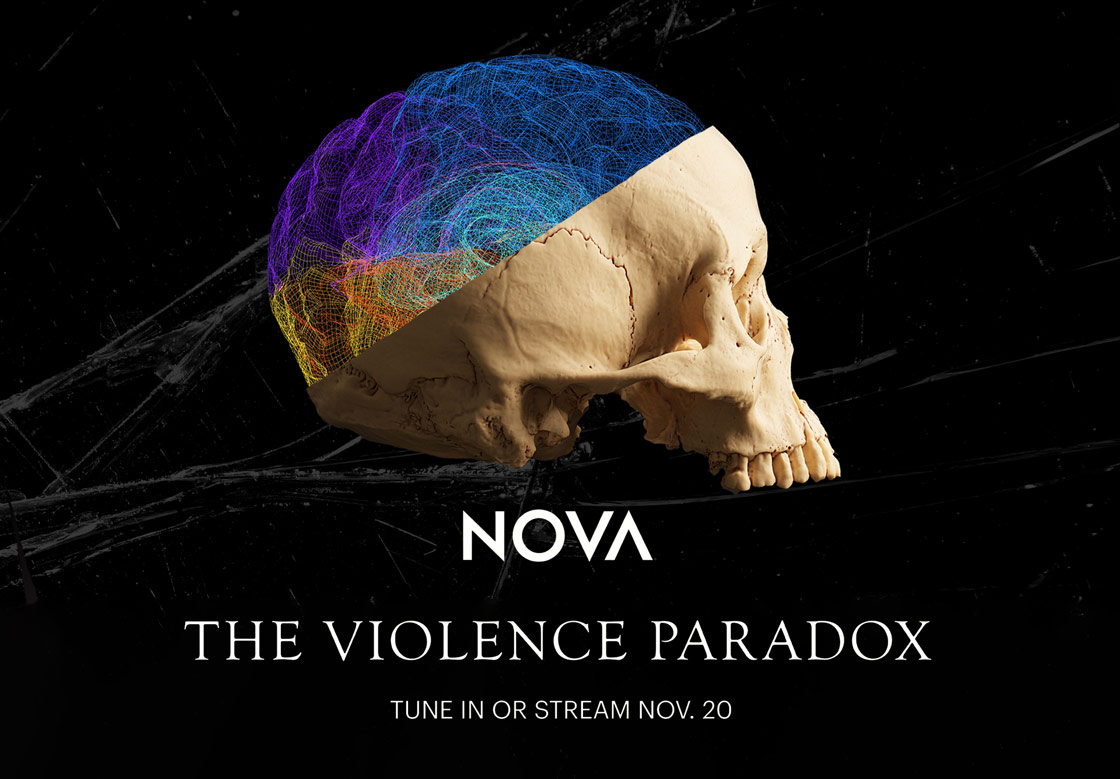
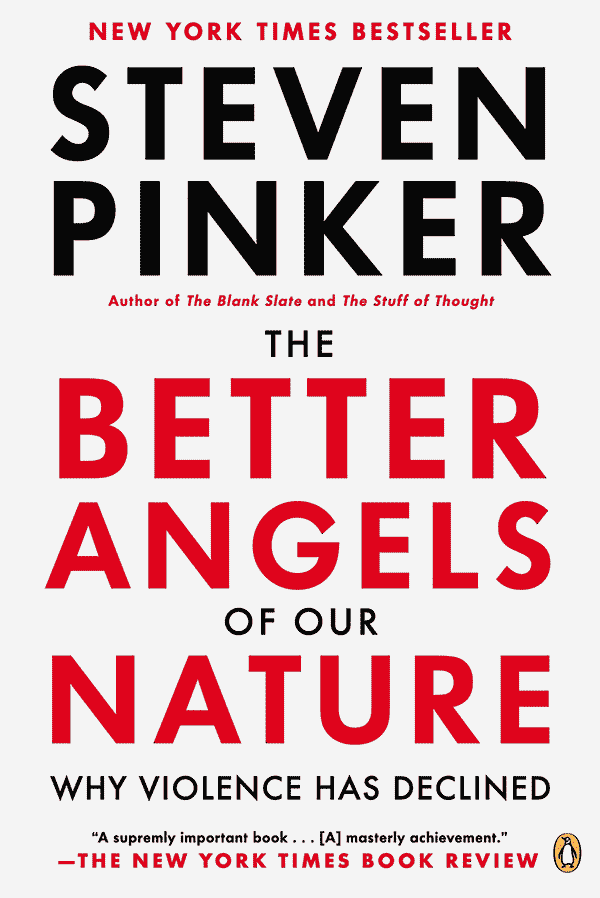
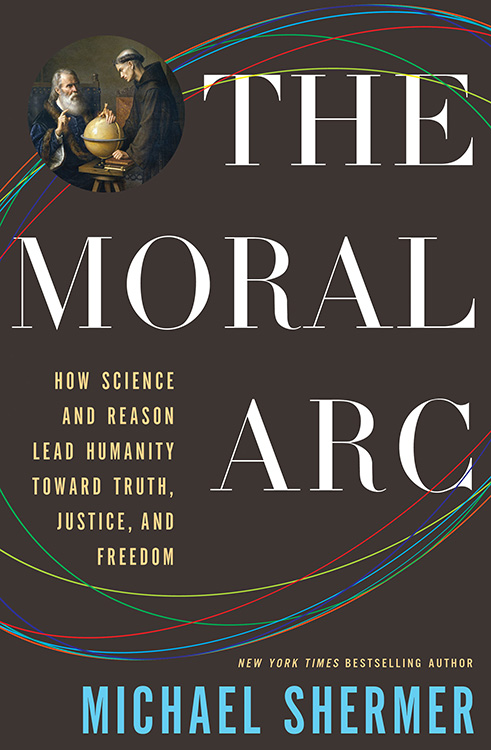









Do Herr Pinker and señor Shermer count abortion as homicide/murder, or no, that good homicide/murder?
I agree with Grumpa, holy sh#t what is wrong with you people?
All I wanted to know is whether the special was worth watching. Thanks to the above male and female freaks of Nature, I think it was. I’m amazed such people even read anything from Skeptic.com.
I watched the NOVA special right up until the final 30 minutes before turning it off and deleting it in disgust. By then it had devolved into a sickening and manipulative attempt to justify state control and the disarming of an entire civilian population before the tyranny of a central government. In my opinion, we still have one more great world war to fight: the one that ends in the total extinction of the Marxist Left in both politics and academia.
This is a good documentary for someone who is trying to be a better person in life, like myself.
Wonderful response, even though a perfect example of male violence in words. Please put this on Twitter and Facebook. The more the issue is broadcast the faster will be its implementation.
There is no other way out of male violence than what I outlined above.
Funny, lots of females agree. The males are never ever going to give up their grip on political, economic and religious power. It has to be wrest from them by enterprising females and males who care for the flourishing of life on earth.
So, what we have above (“Rachel”) is a self-hating man (who is a man) who hates men, who wishes to:
– Disenfranchise men,
– Violate the First Amendment,
– Utilize government power to essentially engage in the same vile practice as the Chinese government (just in reverse),
– Use biotechnology to engage in mind control, with an eye towards,
– Extermination.
Frankly, violence is acceptable to stop the likes of you, “Rachel”, as an evolved response to attack. Only the reduction of violence in the first world allows you to even exist.
Both the Pinker review and Samuels podcast highlight what Pinker alludes to as the “#1 predictor of violence being Maleness”.
Isn’t it time we all confirm that males cause all the trouble in the world? Any primary school teacher knows it’s the boys that cause all the trouble in classrooms.
The 92 % male prison population says it all!
As a transgendered person I have seen the picture from both sides, including war conscription, fraternity hazing, sports competition, even some adult film work.
The guys are completely testosterone driven (which disables pre-frontal cortex inhibitions), territorial in goals and mostly aggressive ruffians when no one is looking (what are team sport event frenzies but warfare in disguise).
We must acknowledge and even commiserate with the male sex being what it is after more than a million years of selection for hunting and warrior ethic. I could even add it’s repression of innate feminine qualities of compassion, tenderness, and non violence (we are all bisexual in physiology and psychology a fact males resist vehemently).
To wit, all those who care for the flourishing of life on earth must:
Elect females to positions of power and decision making.
Marginalize the absurd male dominated religious institutions.
Endeavor to increase female population by government subsidy for female selected births.
Endorse the use of synthetic biology to adjust or eventually reduce the “Y” chromosome negative traits.
Finally modify the scissiparity of sexual reproduction with offspring borne without any male inheritance.
NO MORE MALE GONADS, GODS AND GUNS!!!!!
There has always been tribal and national violence in competition for natural resources. The development of energy from fossil fuels and other technological advances may have abated this for a time as resources were more efficiently and thoroughly exploited. But it is likely that national competition for resources will increase again because of depletion and the consequences of global climate change. There are possibilities for violence on a scale never seen before because of this. Some of those who claim to demonstrate the end to violence do not take account of the limits to resources and the consequences of unrestricted exploitation of them.
Daily life is certainly less violent than it was in pre-civilization times – this is undoubtedly an advance. But there is now vastly more power to kill in times of war, which has not been abolished. Wars since WW II may kill only a “few hundredths of a percent”, but that is hardly characteristic of world war, which may return at any time. There was a lack of world war for almost a century between the Napoleonic wars and WW I, and there has been another such period since WW II, but there is no reason to think this will continue forever. Humans have not magically lost the instincts which caused violence in paleolithic times, or among hunter-gatherers in whatever era or armed forces in whatever culture, and they can be aroused at any time.
Prevention of future world wars may depend on recognition of the existence of such instincts, not on the assumption that they don’t really exist, or that they have been eliminated by modern culture
Michael, please explain how the claim that the world is less violent than it ever has been — which claim naturally implies absolute reduction in violence — could properly be based on studies of *relative* decline in violence *rates* (per capita, per opportunity, etc.)
Just to clarify: with just as much violence in the world now as in 1970 — since which time the global population has a little more than doubled — by your and Pinker’s reckoning, we’d be justified to say that violence has decreased by 50%!
HOORAY! What strides in only 50 years! We’re half as violent as we were in the bloody 70s.
ROFLMAO!
You really gonna stand behind that balderdash?
Pinker has been hard at a snow job these last few years and, instead of calling it out like a real skeptic should, you’re validating and enabling it.
Also, as to your statement…
//
But that slavery has been outlawed by every nation on earth, that none practice colonialism any longer, and that very few engage in torture, is yet another sign of moral progress.
//
Please. Really? That’s an extremely shallow understanding of slavery and colonialism.
Modern-day slavery has not been outlawed anywhere. In fact, our federal and state governments contract with slave management companies to which they’ve outsourced the industry.
Euphemized =/= eliminated.
A good skeptic would notice that.
And colonialism is worse than ever. 800 military bases in 80 countries is what, exactly? The U.S. lending its neighbors a helping hand? SE Asia, Central America, the Middle East, S. America, Africa… exactly which national pies do we *not* have our fingers in, mucking around?
Apparently you accept the mainstream narratives about the nature of U.S. global intermeddling.
Not very skeptical of you.
Please listen and learn from Mallence Bart-Williams about the face of colonialism in our day. I see no indication that it’s doing anything but metastasizing.
https://www.youtube.com/watch?v=AfnruW7yERA